Dekui Wang
GTNet: Graph Transformer Network for 3D Point Cloud Classification and Semantic Segmentation
May 24, 2023Abstract:Recently, graph-based and Transformer-based deep learning networks have demonstrated excellent performances on various point cloud tasks. Most of the existing graph methods are based on static graph, which take a fixed input to establish graph relations. Moreover, many graph methods apply maximization and averaging to aggregate neighboring features, so that only a single neighboring point affects the feature of centroid or different neighboring points have the same influence on the centroid's feature, which ignoring the correlation and difference between points. Most Transformer-based methods extract point cloud features based on global attention and lack the feature learning on local neighbors. To solve the problems of these two types of models, we propose a new feature extraction block named Graph Transformer and construct a 3D point point cloud learning network called GTNet to learn features of point clouds on local and global patterns. Graph Transformer integrates the advantages of graph-based and Transformer-based methods, and consists of Local Transformer and Global Transformer modules. Local Transformer uses a dynamic graph to calculate all neighboring point weights by intra-domain cross-attention with dynamically updated graph relations, so that every neighboring point could affect the features of centroid with different weights; Global Transformer enlarges the receptive field of Local Transformer by a global self-attention. In addition, to avoid the disappearance of the gradient caused by the increasing depth of network, we conduct residual connection for centroid features in GTNet; we also adopt the features of centroid and neighbors to generate the local geometric descriptors in Local Transformer to strengthen the local information learning capability of the model. Finally, we use GTNet for shape classification, part segmentation and semantic segmentation tasks in this paper.
VTPNet for 3D deep learning on point cloud
May 10, 2023Abstract:Recently, Transformer-based methods for point cloud learning have achieved good results on various point cloud learning benchmarks. However, since the attention mechanism needs to generate three feature vectors of query, key, and value to calculate attention features, most of the existing Transformer-based point cloud learning methods usually consume a large amount of computational time and memory resources when calculating global attention. To address this problem, we propose a Voxel-Transformer-Point (VTP) Block for extracting local and global features of point clouds. VTP combines the advantages of voxel-based, point-based and Transformer-based methods, which consists of Voxel-Based Branch (V branch), Point-Based Transformer Branch (PT branch) and Point-Based Branch (P branch). The V branch extracts the coarse-grained features of the point cloud through low voxel resolution; the PT branch obtains the fine-grained features of the point cloud by calculating the self-attention in the local neighborhood and the inter-neighborhood cross-attention; the P branch uses a simplified MLP network to generate the global location information of the point cloud. In addition, to enrich the local features of point clouds at different scales, we set the voxel scale in the V branch and the neighborhood sphere scale in the PT branch to one large and one small (large voxel scale \& small neighborhood sphere scale or small voxel scale \& large neighborhood sphere scale). Finally, we use VTP as the feature extraction network to construct a VTPNet for point cloud learning, and performs shape classification, part segmentation, and semantic segmentation tasks on the ModelNet40, ShapeNet Part, and S3DIS datasets. The experimental results indicate that VTPNet has good performance in 3D point cloud learning.
Multi Point-Voxel Convolution (MPVConv) for Deep Learning on Point Clouds
Jul 28, 2021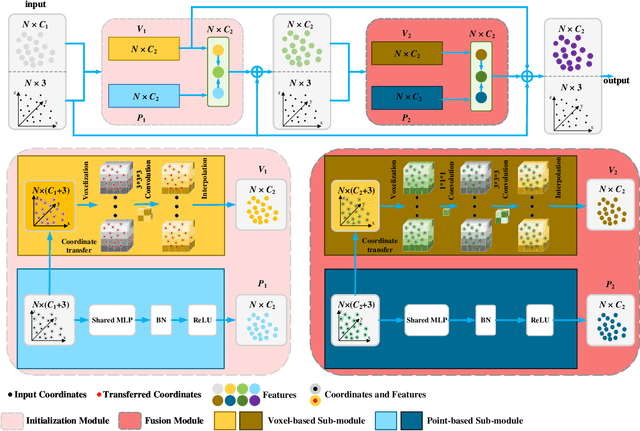
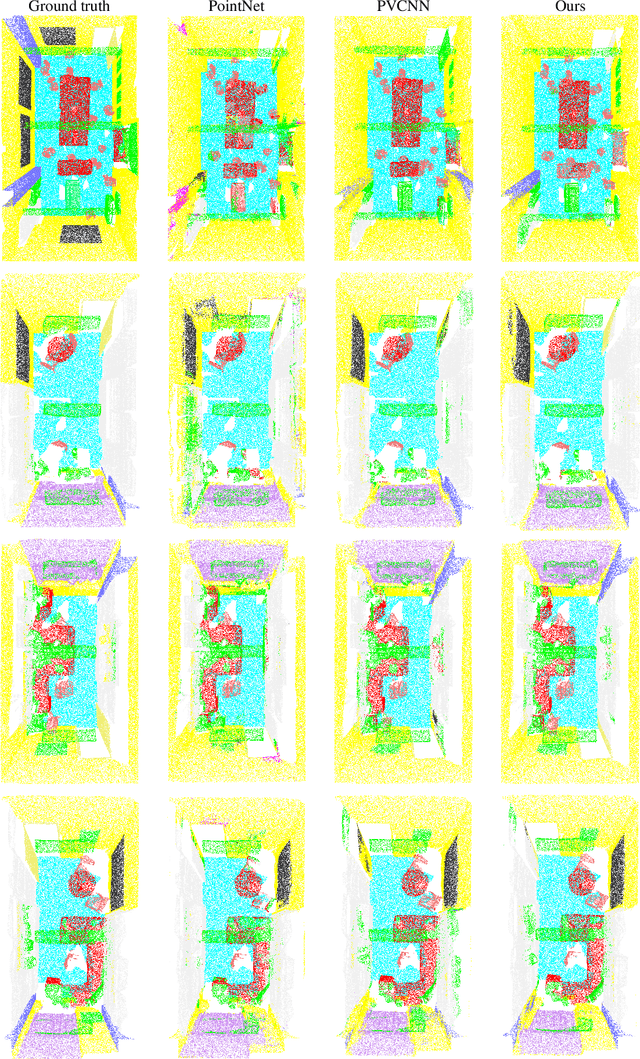
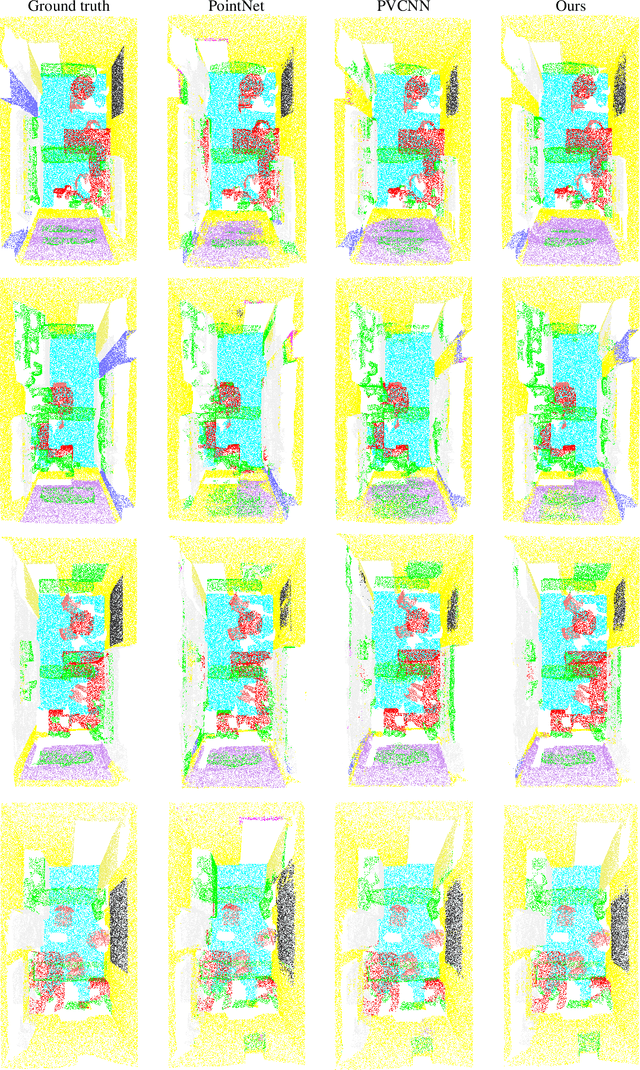
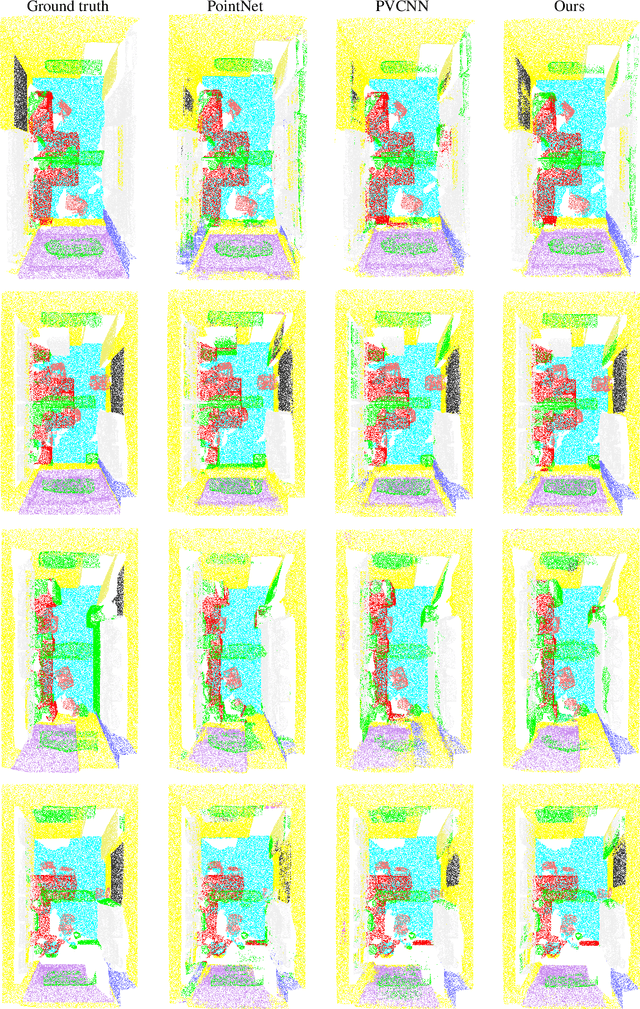
Abstract:The existing 3D deep learning methods adopt either individual point-based features or local-neighboring voxel-based features, and demonstrate great potential for processing 3D data. However, the point based models are inefficient due to the unordered nature of point clouds and the voxel-based models suffer from large information loss. Motivated by the success of recent point-voxel representation, such as PVCNN, we propose a new convolutional neural network, called Multi Point-Voxel Convolution (MPVConv), for deep learning on point clouds. Integrating both the advantages of voxel and point-based methods, MPVConv can effectively increase the neighboring collection between point-based features and also promote independence among voxel-based features. Moreover, most of the existing approaches aim at solving one specific task, and only a few of them can handle a variety of tasks. Simply replacing the corresponding convolution module with MPVConv, we show that MPVConv can fit in different backbones to solve a wide range of 3D tasks. Extensive experiments on benchmark datasets such as ShapeNet Part, S3DIS and KITTI for various tasks show that MPVConv improves the accuracy of the backbone (PointNet) by up to \textbf{36\%}, and achieves higher accuracy than the voxel-based model with up to \textbf{34}$\times$ speedups. In addition, MPVConv outperforms the state-of-the-art point-based models with up to \textbf{8}$\times$ speedups. Notably, our MPVConv achieves better accuracy than the newest point-voxel-based model PVCNN (a model more efficient than PointNet) with lower latency.
Multi Voxel-Point Neurons Convolution (MVPConv) for Fast and Accurate 3D Deep Learning
Apr 30, 2021
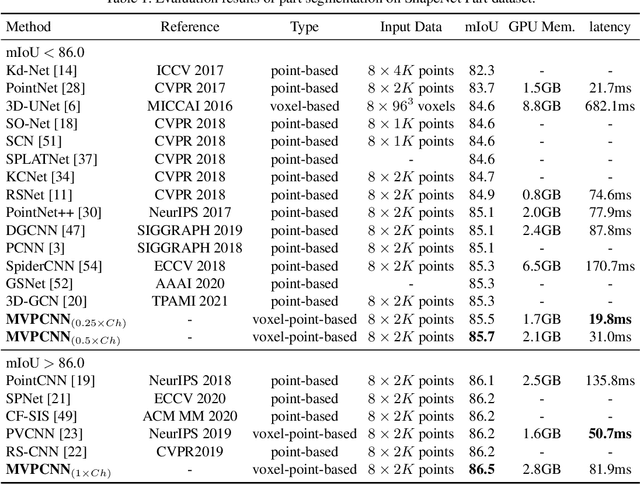

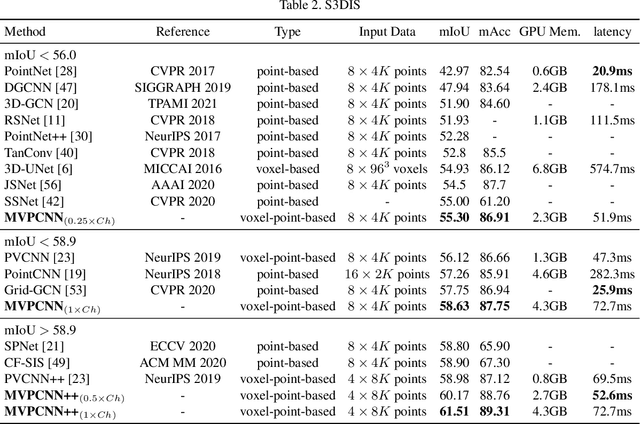
Abstract:We present a new convolutional neural network, called Multi Voxel-Point Neurons Convolution (MVPConv), for fast and accurate 3D deep learning. The previous works adopt either individual point-based features or local-neighboring voxel-based features to process 3D model, which limits the performance of models due to the inefficient computation. Moreover, most of the existing 3D deep learning frameworks aim at solving one specific task, and only a few of them can handle a variety of tasks. Integrating both the advantages of the voxel and point-based methods, the proposed MVPConv can effectively increase the neighboring collection between point-based features and also promote the independence among voxel-based features. Simply replacing the corresponding convolution module with MVPConv, we show that MVPConv can fit in different backbones to solve a wide range of 3D tasks. Extensive experiments on benchmark datasets such as ShapeNet Part, S3DIS and KITTI for various tasks show that MVPConv improves the accuracy of the backbone (PointNet) by up to 36%, and achieves higher accuracy than the voxel-based model with up to 34 times speedup. In addition, MVPConv also outperforms the state-of-the-art point-based models with up to 8 times speedup. Notably, our MVPConv achieves better accuracy than the newest point-voxel-based model PVCNN (a model more efficient than PointNet) with lower latency.
 Add to Chrome
Add to Chrome Add to Firefox
Add to Firefox Add to Edge
Add to Edge